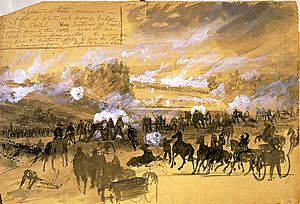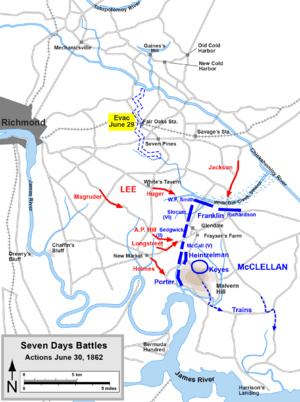Battle of White Oak Swamp facts for kids
Quick facts for kids Battle of White Oak Swamp |
|||||||
|---|---|---|---|---|---|---|---|
| Part of the American Civil War | |||||||
 Battle at White Oak Swamp Bridge Alfred R. Waud, artist, June 1862 |
|||||||
|
|||||||
| Belligerents | |||||||
| Commanders and leaders | |||||||
| William B. Franklin | Thomas J. "Stonewall" Jackson | ||||||
| Units involved | |||||||
| Units from Army of the Potomac | Units from Army of Northern Virginia | ||||||
| Casualties and losses | |||||||
| ~100 | 15 total 3 killed 12 wounded |
||||||
The Battle of White Oak Swamp happened on June 30, 1862, in Henrico County, Virginia. It was part of the Seven Days Battles during the American Civil War. The Union forces, called the Army of the Potomac, were trying to retreat to the James River. Their rear guard, led by Maj. Gen. William B. Franklin, faced off against Maj. Gen. Thomas J. "Stonewall" Jackson's Confederate divisions at the White Oak Bridge.
This battle mostly involved an artillery duel, meaning cannons firing at each other. Meanwhile, a bigger fight, the Battle of Glendale, was happening nearby. Because Franklin's troops held their ground, Jackson couldn't join the main attack on the Union Army at Glendale. This meant the battle ended without a clear winner. The Union Army avoided being completely defeated and managed to get to a strong defensive spot at Malvern Hill.
Contents
Why the Battle Happened: The Military Situation
The Seven Days Battles were a series of fights that started on June 25, 1862. The Union Army, led by General George B. McClellan, first attacked in a small battle. But soon, the Confederate Army, led by General Robert E. Lee, took charge. Lee launched several attacks, pushing the Union forces back.
McClellan's army was trying to retreat to a safe place called Harrison's Landing on the James River. By noon on June 30, most of his army had crossed White Oak Swamp Creek. However, a large part of the army was still marching between the swamp and Glendale.
General Lee wanted to trap the retreating Union forces. He ordered his Army of Northern Virginia to attack them. Stonewall Jackson was told to stop the Union rear guard at White Oak Swamp. At the same time, the main part of Lee's army (about 45,000 soldiers) would attack the Union Army at Glendale, about 2 miles (3 km) away. The goal was to split the Union Army in two.
Stonewall Jackson was famous for his brilliant campaign in the Shenandoah Valley. But during the Seven Days Battles, his performance hadn't been as good. He was late to several battles. The fight at White Oak Swamp was another chance for him to help Lee's plan. Lee and Jackson met that morning, and Lee's orders were for Jackson to keep the Union forces at White Oak Swamp busy so they couldn't send help to Glendale.
The last Union group to pass through White Oak Swamp was the VI Corps. This group was led by Brig. Gen. William B. Franklin. It included divisions led by Brig. Gens. William F. "Baldy" Smith and Israel B. Richardson. These were the troops Jackson was supposed to stop.
Who Fought: The Armies
Union Forces
Confederate Forces
The Battle Unfolds
Jackson's soldiers marched south towards White Oak Swamp. Their artillery chief, Colonel Stapleton Crutchfield, led the way. They moved slowly because they had many wounded Union prisoners and supplies from a previous battle. When they reached the swamp, they found that the only bridge had been burned a few hours earlier.
Jackson arrived around noon. He approved Crutchfield's plan to set up cannons on a ridge. These cannons would fire across the swamp at the Union positions, which were about 300 yards away. At 2 p.m. on June 30, seven Confederate artillery batteries (31 cannons in total) opened fire. They surprised the Union troops and damaged some of their cannons.
Jackson ordered his engineers to start rebuilding the bridge. He also sent Colonel Thomas T. Munford's 2nd Virginia Cavalry to cross the swamp. Their mission was to capture some Union cannons that had been left behind. As the soldiers and horses struggled through the deep, messy water, Jackson and Maj. Gen. D.H. Hill crossed the river themselves to scout the area. A Union artillery shell exploded very close to them, but neither general was hurt. Jackson saw that the Union side was bringing in more cannons and soldiers. He also realized that Union sharpshooters would make it very hard for his engineers to rebuild the bridge. He understood that attacking across the swamp here would be too difficult.
Munford reported finding a shallow spot (a "ford") about a quarter-mile downstream where infantry could cross. Another officer, Brig. Gen. Wade Hampton, found an even closer spot where a simple bridge could be built for soldiers on foot. Jackson ordered him to build this bridge. However, Jackson didn't take any specific steps to cross the swamp. He decided it wasn't possible to attack if he couldn't get his cannons across. While the cannon fight across the swamp grew bigger, and the battle at Glendale raged nearby, Jackson sat under a large oak tree and fell asleep for over an hour.
What Happened Next: The Aftermath
Because Jackson didn't act, some Union units from Franklin's corps were able to leave White Oak Swamp. They went to help the Union troops fighting at Glendale later that afternoon. Jackson didn't tell Lee about his situation, and Lee didn't send anyone to check on Jackson until it was too late to change the outcome of the main battle.
Even though Jackson's part of the army and Franklin's corps had tens of thousands of soldiers, the fighting at White Oak Swamp was mostly just cannons firing at each other. There was no major infantry (foot soldier) battle. The Confederates lost 3 artillerymen killed and 12 wounded. We don't have an exact count for Union casualties, but historian Brian K. Burton estimates around 100 Union casualties. The 5th New Hampshire regiment had the most losses, with 5 men killed and 9 wounded.
After dinner that night, Jackson fell asleep again, still holding a biscuit. When he woke up, he said, "Now, gentlemen, let us at once to bed, and rise with the dawn, and see if tomorrow we can do something." Two weeks later, he explained why he had been so slow during the battle: "If General Lee had wanted me, he could have sent for me." General Lee never criticized Jackson's actions in this battle.
Edward Porter Alexander, a famous Confederate artillery commander and historian, later wrote about the big chance that was missed at Glendale and White Oak Swamp. He felt it was a shame that "our Stonewall Jackson lost them."
Images for kids
See also
 In Spanish: Batalla de White Oak Swamp para niños
In Spanish: Batalla de White Oak Swamp para niños




